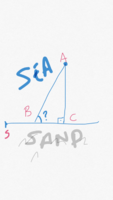A man running on a straight seaside, sees a person drowning on point A, 100 mts from the closest beach point C. At the time he sees, he is 1.000mts away from the beach point that is closest (point S)
His swimming speed is 1/x of his running speed where x>3
Find the angle (ABC) where the man needs to jump into water and swim in terms of x, in which it will be the fastest way to reach drowning person.
It is easy to approximate by using excel and trying numbers, but I could not create a limit function to demonstrate with unknown value x

For example if AC is 1000 mt, and x=5, then BC is approximately 204 meters. Thus you can calculate an angel from there.
But in formulisation I was stuck.
Thanks for any help
His swimming speed is 1/x of his running speed where x>3
Find the angle (ABC) where the man needs to jump into water and swim in terms of x, in which it will be the fastest way to reach drowning person.
It is easy to approximate by using excel and trying numbers, but I could not create a limit function to demonstrate with unknown value x

For example if AC is 1000 mt, and x=5, then BC is approximately 204 meters. Thus you can calculate an angel from there.
But in formulisation I was stuck.
Thanks for any help
Last edited by a moderator:
